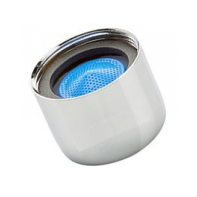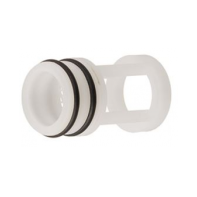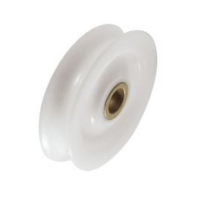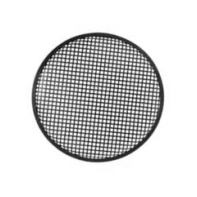POM | Polyoxymethylene
Thermoplastics > Acetal

| XFORM - POM (polyoxymethylene) - Acetal resins | ||
| POM-C Product range | ||
We have numerous grades of copolymer POM that are classified into various categories among which are: Unfilled, with fibers or glass beads (glass10-40%), are also reinforced anisotropically with minerals , low wear with molybdenum disulfide, with PTFE, PE, (low wear), modified to impact (impact modified), with ultra violet UV resistance, with mineral load (mineral coupled), antistatic (antistatic), electrically conductive (electrically conductive), with silicone oil to improve dry sliding characteristics and wear. The POMs are supplied in the form of opaque (natural) or colored granules. The degrees for extrusion and extrusion-blowing have a very low MFI, for injection, more or less MFI of 9-13. There are special grades for galvanized or metallized grades in mass. |  | |
| Acetal | ||
Non-reinforced homopolymers (POM-H) are the most rigid and resistant thermoplastics and have excellent dimensional stability. They become brittle at temperatures below -40°C. High surface hardness and low coefficient of friction impart a good sliding behavior and wear resistance. The permeability to gases and vapors, also of organic substances, is low. The homopolymers and the copolymers are attacked by strong acids (pH 4) and oxidizing agents, both are not soluble and hardly swell in all kinds of organic solvents in use, and also feed minerals. The special stabilized oils are resistant to aggressive diesel and gasoline fuels up to a temperature of 100 ° C. Not stabilized are attacked by UV rays, so it is advisable to use those UV stabilized or charged with carbon black. The color formulations are available with stabilization. The thin film POMs are transparent; burn with a slightly bluish flame and drip. They are physiologically safe and some types are suitable for products homopolymers. The homopolymers have higher crystallinity, giving it better impact resistance and slightly higher stiffness and hardness, while the copolymers provide greater comfort and are easier to process. | 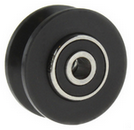 | |
| Properties Acetal | ||
|  | |
| Pros and cons Polyacetal | ||
Pros
Cons
| ||
| Acetal properties | ||
The acetal polymers are semicrystalline, the copolymer has a double bond [C-C], it is a type of crystallized resin with the formula of - (CH2-O) n- (CH2-CH20) m. They offer excellent inherent lubricity, resistance to fatigue and chemical resistance. Acetals suffer from degassing problems at high temperatures and are brittle at low temperatures. Filled with glass, and additional lubrication grades are available, fire retardant grades are not. Acetal resin more commonly known as "Acetal" or "POM", is a plastic material called self-lubricated. It has a good creep resistance, this means that they are good to maintain their shape during long exposures to loads and maintain a tighter fit in pressure adjusting applications. The homopolymers have a higher crystallinity, providing better impact resistance, greater rigidity and hardness, while the copolymers provide greater comfort and are easier to work with. The POM has the lowest wear resistance of almost all thermoplastic materials at room temperature, which is lowered in dirty and dusty environments due to its high dimensional stability, making it suitable for gears and cushions. |  | |
| Copolymer of acetal POM | ||
The copolymer grade offers excellent performance at a slightly lower cost than that of the homopolymer. The acetal copolymer offers consistent properties throughout the shape (without the porosity of the center line). Centered porosity is caused by gases that try to escape during the cooling process after the extrusion or compression manufacturing process. Low voltage levels and high strength ensure flatness and dimensional stability up to a maximum continuous operating temperature of 80 ° C. The copolymer acetal grades are compatible with FDA, USDA, NSF and 3-A Dairy. Other advantages over acetal homopolymer are:
|  | |
| POM-C vs. POM-H | ||
Acetal copolymer and POM homopolymer are engineering plastics known as polyoxymethylene (POM) and are members of the family of thermoplastic polyester. The POM is available in 2 different resins: acetal copolymer (POM-C) and acetal homopolymer (POM-H). For most applications, it does not really matter if copolymer or homopolymer is used, since many properties are similar. In particular, the most significant difference between homopolymer and acetal copolymer is related to what is commonly referred to as centerline porosity, an inherent characteristic of homopolymer. This is one of the major problems of the homopolymer to consider is its structural integrity, it has a potential for leakage, it has an inconsistent aesthetic appearance of color and it has areas where bacteria can grow, which is especially important in food processing applications. If the porosity of the center line is not a problem then the homopolymer has slightly better mechanical properties. This porosity of the homopolymer appears as a line along the center of each cut edge. Excessive porosity of the central line is not desirable for the following reasons:
The cause of the porosity is the contraction. During the extrusion process, the outside of the form cools before the inside. As the inner material cools, there is a corresponding reduction in volume. Since the volume change of the shape is restricted due to the solidified skin, gaps are formed to compensate for the loss of interior volume. | ||
| Electricals properties POM | ||
Good capacity as electrical insulator, good surface resistance and good resistance to reptile currents. They have dielectric loss at high frequencies, but a great use is made at low frequencies | ||
| Thermal properties POM | ||
The copolymer POM is usable for prolonged periods of time at temperatures of up to 70 ° C to 80 ° C, with a peak at 120 ° C for short periods. Prolonged exposure to 100 ° C higher temperature causes rapid oxidative degradation of the polymer. Flammable and sensitive to heat. They burn with a sometimes invisible blue flame and emit formaldehyde gas when they burn. Flammability Polyacetals ignite when exposed to the flame, continue to burn with a pale blue flame when the source of ignition is removed and drip as they burn. When they are extinguished or if they continue to burn, they emit a formaldehyde that smells. According to the flammability test UL 94, acetal is classified as "HB". It is not possible to produce a product with the classification "V-0". The combustion speed determined according to the FMVSS 302 standard thickness> 1 mm is 75 mm / min and at 3 mm thickness is 25 mm / min. | ||
| Chemicals resistance POM | ||
Resistant to chemical products and mostly not affected by solvents and fuels, etc. POM is chemically resistant to alkalis, aliphatic and aromatic hydrocarbons, oils, fats, gasoline and most cleaning agents. POM is not resistant to UV and outdoor applications are possible only with qualities stabilized with activated carbon. It is not resistant to strong acids or oxidizing materials. Acetal resin POM is a resistant material with a very low coefficient of friction. However, it is susceptible to degradation of the polymer catalyzed by strong acids (pH <4), so both types of polymers are stabilized. The POM is a tenacious material with a very low coefficient of friction. It is sensitive to oxidation, and an antioxidant is usually added to materials with molding quality. However, they do not react well with chlorine, so it would not be ideal for pool applications. The semi-acetal-O-C-OH end groups are initially unstable and are stabilized by esterification with acetic anhydride. The chemical attack of these ester bonds by water or alkalis leads through the hydrolysis of these bonds to a progressive decomposition of the polymer chain. This decomposition can be delayed by stabilization. |  | |
| Processability POM | ||
POM can be easily molded by means of injection, or using the rotation system. Sheet, bars, rings and tubes (plasticized or not) can also be produced using extrusion. One of its most popular properties in the engineering plastics community is its ease of machining. Compared to other engineering plastics, such as HDPE, UHMW and polyamide, the acetal copolymer and the homopolymer tend not to deviate from the machining tools or grab them, and they also splinter, which makes them ideal if an application requires that the material be machined. Semi-finished parts, sheets, rods and rings are very easy to process mechanically, and form physical foam. The pieces can be folded in the field of crystalline temperature and can be welded (by heating element, friction or ultrasound), but can not be glued in high strength joints with adhesives. For finishing by lacquering or vacuum plating, it is necessary to treat the etching surface with acidic agents. The polyacetals are not attacked by the solvents of the printing ink and can be printed only immediately after a plasma or corona treatment or acid attack. |  | |
| Applications POM | ||
The high mechanical strength, rigidity and hardness make them a good alternative to metal if all the resistance of the metal is not required, but other properties of the plastic, low thermal expansion and low water absorption. Industrial applications of the acetal homopolymer include couplings, pump impellers, conveyor plates, gears, sprockets and springs. They are materials specially indicated for parts that suffer friction and / or sliding, pinions, sliding rulinas, guides. Particularly suitable for replacing precision metal parts for technical use, for example, gears, levers, bearings, wheels, rollers, precision bearings, bushings, pinions, low modulus sprockets, gears, levers, pump components, electronic machines, toilet equipment, parts and components of elevators, vcrilllers, eccentric screws, coils, bushings, bearings, guides, conveyor chains, cams, couplings, slides, parts of valves and pumps, reels, seals, washers, seats, support for spare parts , parts for various housings, rolling cylinders, bearing edges, plugs for plugs, insulators, parts for kneading and stirring, roller joints, cams, particular pieces of pumps for textile machines, accessories for pipes, components of the pump for hot water or fuel, transmission cylinder in nail gun, water pump housing, grille for parlant it's cars, showers, zip fasteners, fishing reels and writing pens, connectors and gears for toys, gears for washing machines, covers for chair bases, precision assemblies for medical tubes, fuel tank, printer gears, tools hand-held, components of gas meters, washing machine transmission, hood opening levers and fuel tank marked with LASER, power transmission gears in safety belts, examples of plastics in toys, buttons of control panels. Applications for FDA-approved grades include milk pumps, coffee ears, filter housings, and food conveyors. Parts that require higher load bearing stability at elevated temperatures, such as cams, gears, TV tuner arms and lower car components, are molded from grades reinforced with fiberglass. POM-PUR blends are used to produce products with high shock resistance, such as chain sprockets, channel parts, fasteners, ski bindings and integral hinges. Automotive automotive applications of acetal resins include fuel system and seatbelt components, steering columns, window supports and handles. Typical plumbing applications that have replaced the brass or zinc components are shower heads, ball valves, faucet cartridges and various accessories. Consumer items include quality toys, garden sprays, stereo cassette parts, butane lighter bodies, zippers and door and telephone components, clips, lugs, door handles, window cranks, housings and belt components of security. |  |


